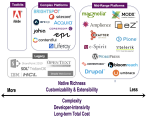Placed and placeless content in Vignette
CMS Watch is frequently -- and I think justifiably -- critical of Vignette's "VCM" web content management platform (c.f., my review of their new management interface).
But in fairness, there is one thing that the product does fairly well, though it's not always easy to get a handle on it.
Here's what it is. After a history of poor metadata and taxonomy support, Vignette implemented a real classification system on top of its traditional "channels" motif of binding content items to your site hierarchy. Also, editorial teams can organize content items into arbitrarily-structured "projects" on the back end. Combined, these three ways of organizing content can be quite useful.
First, it allows you to have "placed" and "placeless" content on the same site, or even the same page. That is, sometimes contributors need to actively place content in a particular spot or spots and know it will appear there. In other cases, you want content to appear according to its classification (you tagged a content item "Manitoba", so it will appear in the "Canada" section of your site). With most Web CMS tools, you have to have to choose between placed or placeless approaches, and many customers are quite rightly reluctant to turn their entire site over to a placeless, metadata-driven model where authors and managers alike can never be quite certain where a new page will appear. With Vignette, you can tag content against a hierarchical taxonomy, as well as assign items to particular "channels" which are representations of website locales. In a well thought-through publishing regime, this combination can offer a lot of power.
On the back-end, being able to organize content items against an arbitrary scheme that doesn't actually reflect the published site is also handy. It makes it easier for individuals and teams to work on ad-hoc projects, sorting and storing information in a way that makes sense to them, before it gets published.
Note that Vignette salespeople don't always describe these features very well. "We have three taxonomies," one rep explained rather unhelpfully at a customer pitch I saw recently. To be sure, for a simple site, three organizational models is more of a liability than an asset. But for complex publishing operations, I think this kind of flexibility is quite handy.








